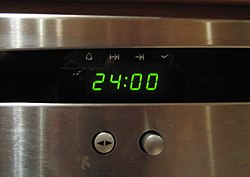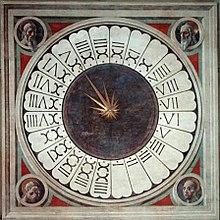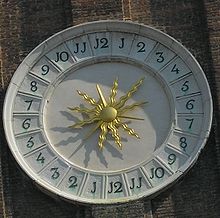24-hour clock
| 24-hour clock | 12-hour clock |
|---|---|
| 00:00 | 12:00 a.m. (start of day) "12 midnight" |
| 01:00 | 1:00 a.m. |
| 02:00 | 2:00 a.m. |
| 03:00 | 3:00 a.m. |
| 04:00 | 4:00 a.m. |
| 05:00 | 5:00 a.m. |
| 06:00 | 6:00 a.m. |
| 07:00 | 7:00 a.m. |
| 08:00 | 8:00 a.m. |
| 09:00 | 9:00 a.m. |
| 10:00 | 10:00 a.m. |
| 11:00 | 11:00 a.m. |
| 12:00 | 12:00 p.m. 12 noon |
| 13:00 | 1:00 p.m. |
| 14:00 | 2:00 p.m. |
| 15:00 | 3:00 p.m. |
| 16:00 | 4:00 p.m. |
| 17:00 | 5:00 p.m. |
| 18:00 | 6:00 p.m. |
| 19:00 | 7:00 p.m. |
| 20:00 | 8:00 p.m. |
| 21:00 | 9:00 p.m. |
| 22:00 | 10:00 p.m. |
| 23:00 | 11:00 p.m. |
| 24:00 | undefined ("12 midnight")* (end of day) |
| * See "Confusion at noon and midnight" | |
The 24-hour clock is a convention of time keeping in which the day runs from midnight to midnight and is divided into 24 hours, indicated by the hours passed since midnight, from 0 to 23. This system is the most commonly used time notation in the world today.[1] The 12-hour clock is, however, still dominant in a handful of countries,[1] particularly in Australia, Canada (except Quebec) and the United States. In South Africa both time systems are used, although, 12 hour time is mostly used in vocal speech for ease of use, and 24 hour time is preferred in writing. 24-hour notation is also popularly referred to as military time or astronomical time in the United States and Canada,[2] and in Australia (though rarely).[citation needed] In some parts of the world, it is called railway time or continental time. It is also the international standard notation of time (ISO 8601).[3] In the practice of medicine, the 24-hour clock is generally used in documentation of care as it precludes any ambiguity as to what time events occurred in the patient's medical history.
Description
A time of day is written in the 24-hour notation in the form hh:mm (for example 01:23) or hh:mm:ss (for example, 01:23:45), where hh (00 to 23) is the number of full hours that have passed since midnight, mm (00 to 59) is the number of full minutes that have passed since the last full hour, and ss (00 to 59) is the number of seconds since the last full minute. In the case of a leap second, the value of ss may extend to 60. A leading zero is added for numbers under 10. This zero is optional for the hours, but very commonly used, especially in computer applications, where many specifications require it (for example, ISO 8601). Where subsecond resolution is required, the seconds can be a decimal fraction, that is, the fractional part follows a decimal dot or comma, as in 01:23:45.678. The most commonly used separator symbol between hours, minutes and seconds is the colon, which is also the symbol used in ISO 8601. In the past, some European countries used the dot on the line as a separator, but most national standards on time notation have since then been changed to the international standard colon. In some contexts (e.g., U.S. military, some computer protocols), no separator is used (e.g., 2359) and in some jurisdictions (France and Quebec) the letter h (for "heure") is used when indicating hours and minutes only (18h45).
Midnight 00:00 and 24:00
In the 24-hour time notation, the day begins at midnight, 00:00, and the last minute of the day begins at 23:59. Where convenient, the notation 24:00 may also be used to refer to midnight at the end of a given date—that is, 24:00 of some day is the same time as 00:00 of the following day.
The notation 24:00 mainly serves to refer to the exact end of a day in a time interval. A typical usage is giving opening hours ending at midnight, e.g. "00:00–24:00", "07:00–24:00". Similarly, some railway timetables show 00:00 as departure time and 24:00 as arrival time. Legal contracts often run from the start date at 00:00 till the end date at 24:00. It should be stressed, however, that "24:00" is a notation for the purposes of avoiding ambiguity and does not represent a genuine clock time. 4th July 24:00 is, strictly speaking, 00:00 of the following date since it cannot simultaneously be two different dates.
While the 24-hour notation does unambiguously distinguish between midnight at the start (00:00) and end (24:00) of any given date, there is no such commonly accepted distinction among users of the 12-hour notation. Therefore, style guides and military communication regulations in some English-speaking countries discourage the use of 00:00 and 24:00 even in the 24-hour notation, and recommend to report times near midnight as 23:59 or 00:01 instead, to avoid misunderstandings when such times are converted into the 12-hour notation later.[4]

Time-of-day notations beyond 24:00 (such as 24:01 or 25:59) are neither commonly used nor covered by any relevant standards. However, they have been observed occasionally in some special contexts in Japan and Hong Kong where business hours extend beyond midnight, such as broadcast-television production and with time-validation stamps on some European public transport systems, such as those used in Copenhagen, which may show, for example, 27:45 instead of 03:45.
Most digital clocks and watches show times between 00:00 to 23:59. As a notable exception, the digital clocks of at least one European manufacturer of kitchen appliances show 24:00 for midnight, rather than the standard 00:00, with an example being Bosch Siemens microwaves.
The 24-hour clock in spoken English
- See also Names for the number 0
The U.S. military uses the 24-hour clock exclusively and would typically pronounce full hours as the number-word for the hour followed by "hundred" with an optional "hours" ("hours" is not used in the U.S. Navy or the U.S. Marine Corps) to clarify that the speaker is referring to a time of day. For instance, 1600 would be pronounced "sixteen hundred" or "sixteen hundred hours". The time 1830 is usually pronounced "eighteen thirty". 1000 is "ten hundred" rather than "one thousand"; hence, 2000 is "twenty hundred".
Both "eighteen o'clock"[citation needed] and "eighteen hundred" are commonly encountered spoken English for 18:00. Contrary to popular belief, the use of the word "hours" at the end of the stated time is not standard in the U.S. military. The use of the 24-hour clock without the word "hours" is the standard for expressing time in the U.S. military. The time 18:05 is commonly pronounced either "eighteen oh five" or "five past eighteen". In U.S. military usage, a leading zero for the hours before 10:00 is pronounced as well, as in "oh three oh five" or as "zero three zero five" for 03:05, but this would be considered unusual in a civilian setting.
Taking as an example, on many of the United Kingdom's railways, the public announcement system refers to 24-hour times as: 06:59 "oh six fifty-nine", to 07:00 "oh seven hundred hours"[citation needed]. "Midnight exactly" is used for 00:00 (however no train in the United Kingdom is shown to depart at 0000 or 2400 to avoid any ambiguity), but when they depart at, for example, 00:26, it is announced as "midnight twenty-six". It is also common to hear the hour spoken as "seven hours Greenwich Mean Time" (written 07:00, for instance), as heard on the BBC World Service radio broadcasts in the US. On the display boards at Birmingham New Street, mirroring the majority of stations in the UK, and timetables, the time is written as HHMM, as in 0659 or 0700 for 'one minute to-' and 'seven o'clock' respectively.
In common with what happens with units, the written and spoken forms of time do not always match. For example, it is possible for a train time to be written as "18:30" but a person may say "there is a train at half-past".

Computer support
In most countries, computers by default show the time in 24-hour notation. For example, Microsoft Windows activates the 12-hour notation by default only if a computer's language and region settings are:
- Albanian
- Chinese (Taiwan)
- English (only in Australia, Belize, Canada, Caribbean, Jamaica, New Zealand, Philippines, Trinidad, South Africa, United States, and Zimbabwe)
- Greek
- Spanish (only in Mexico and parts of South America)
- Swahili
Usually, users can easily switch to the 24-hour notation in such locales, without affecting any of the other regional preferences.
Military time
In Canada and the United States, the term "military time" is a synonym for the 24-hour clock.[5] In these regions, the time of day is customarily given almost exclusively using the 12-hour clock notation, which counts the hours of the day as 12, 1, ..., 11 with suffixes 'a.m.' and 'p.m.' distinguishing the two diurnal repetitions of this sequence. The 24-hour clock is commonly known there only in a few specialist areas (military, aviation, navigation, meteorology, astronomy, computing, logistics, emergency services, hospitals), where the ambiguities of the 12-hour notation are deemed too inconvenient, cumbersome, or outright dangerous, with the military's use being historically the first and most famous example. The term "military time" has no particular meaning in most other regions of the world, where the 24-hour clock has long become a common element of every-day civilian life.
In the United States military, military time is similar to the 24-hour clock notation, with the exception that the colon is omitted and the time on the hours is often spoken as its decimal value. For instance, 6:00 a.m. would become 0600, and would be spoken as "zero six hundred", "oh six hundred", or "zero six zero zero". However none of these formatting or pronunciation details is in fact exclusively military, and all are common in the technical contexts in which the 24-hour clock is generally used in English-speaking countries.
There are some differences between military usage and other twenty-four-hour time systems:
- Written military time does not usually include a time separator (for example, "0340" is more common than the civilian "03:40").
- The first hour in military time is always "00"; civilian twenty-four hour systems may use "24" or "0".
- "Hours" is usually not appended in civilian use (15:00 may be pronounced "fifteen hundred hours", which is unusual in a non-military setting).
- Leading zeros are not pronounced in non-military usage (05:43 would be "five forty-three", as opposed to "oh five forty-three").
- Military timestamps on messages have the time zone where applicable appended; in a civilian setting, this would be redundant.
History


The 24-hour time system has been used for centuries, primarily by scientists, astronomers, navigators, and horologists. Numerous examples of clocks using the 24-hour system have been built, ranging from John Harrison's H1 chronometer to the Shepherd gate clock at Greenwich.
The British and Canadian militaries first started to use the 24-hour clock in late 1917.[6] Previous to this, military orders were drafted using the familiar "a.m." and "p.m." suffixes.
In Britain, the use of the 24-hour clock in daily life has grown steadily since the beginning of the 20th century. In 1934, the Radio Times switched to the 24-hour clock for programme listings. The experiment was halted after five months following widespread protests from readers, and has used the 12-hour clock ever since. More recently, BBC Weather television forecasts used the 12-hour notation for several months in 2005, after its graphical revamp. After complaints from the public, however, this was switched to 24-hour notation.
See also
- Time
- Clock
- Decimal time
- Zulu time
- 24 hour analog dial
- Thai 6-hour clock
- Date and time notation by country
- List of military time zones
References
- ^ a b See the Common Locale Data Repository for detailed data about the preferred date and time notations used across the world, as well the locale settings of major computer operating systems, and the article Date and time notation by country.
- ^ U.S. Government Printing Office, Style Manual
- ^ International Standard ISO 8601: Data elements and interchange formats – Information interchange – Representation of dates and times. International Organization for Standardization, 3rd ed., 2004.
- ^ Communication instructions – General, Allied Communications Publication ACP 121(H), Combined Communications-Electronics Board, April 2007
- ^ Space Archive: Military Time.
- ^ Dancocks, Daniel G. Gallant Canadians: The Story of the 10th Canadian Infantry Battalion 1914-1919


